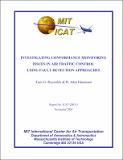Investigating Conformance Monitoring Issues in Air Traffic Control Using Fault Detection Approaches
Author(s)
Reynolds, T. G.; Hansman, R. J.
Download206_ReynoldsPhD_ICATreport.pdf (3.533Mb)
Metadata
Show full item recordAbstract
In order to maintain Air Traffic Control (ATC) system safety, security and efficiency, conformance
monitoring must be performed to ensure that aircraft adhere to their assigned clearances. New Decision
Support Tools (DSTs), coupled to advanced communication, navigation and surveillance technologies are
being developed which may enable more effective conformance monitoring to be undertaken relative to
today. However, there are currently no general analysis techniques to help identify fundamental
conformance monitoring issues and more effective approaches that new DSTs should employ.
An approach to address this need is presented in this work that draws parallels between ATC
conformance monitoring and general system fault detection, allowing fault detection methods developed
for other domains to be employed for this new application. The resulting Conformance Monitoring
Analysis Framework provides a structure to research conformance monitoring issues and approaches.
Detailed discussions are presented for each of the elements of the framework, including the Conformance
Basis, Actual System Representation, Conformance Monitoring Model, Conformance Residual
Generation and Decision-Making components. Flight test data during a simple lateral non-conformance
maneuver was used to demonstrate various implementation options of the framework.
Application of the framework for ATC conformance monitoring research was demonstrated using flight
test and simulator data in various operational and surveillance environments. Key findings in the lateral,
vertical and longitudinal domains during non-transitioning and transitioning flight regimes are presented.
In general, it was found that more effective conformance monitoring can be conducted relative to existing
systems in the non-transitioning environments when advanced surveillance systems provide higher
accuracy, higher update rate and higher order dynamic state information for use in more sophisticated
DST algorithms. This is contrasted to the significantly greater conformance monitoring challenges that
exist in the transitioning regimes due to Conformance Basis and modeling uncertainties. These
challenges can be handled through the use of procedural design, higher fidelity modeling techniques or
the surveillance of intent states. Two extended applications of the framework are also presented: a
method for intent inferencing to determine what alternative trajectory a non-conforming aircraft may be
following and a technique for environmental parameter estimation.
Date issued
2003-11Series/Report no.
ICAT-2003-5
Keywords
air traffic control, system safety, conformance monitoring, Decision Support Tools, navigation, surveillance technologies